Synthesizer
A synthesizer (also spelled synthesiser)[1] is an electronic musical instrument that generates audio signals. Synthesizers generate audio through methods including subtractive synthesis, additive synthesis, and frequency modulation synthesis. These sounds may be shaped and modulated by components such as filters, envelopes, and low-frequency oscillators. Synthesizers are typically played with keyboards or controlled by sequencers, software, or other instruments, often via MIDI.
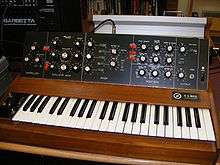
Synthesizer-like instruments emerged in the United States in the mid-20th century with instruments such as the RCA Mark II, which was controlled with punch cards and composed of hundreds of vacuum tubes. The Moog synthesizer, developed by Robert Moog and first sold in 1964, is credited for pioneering analog synthesis concepts such as voltage-controlled oscillators, envelopes, noise generators, filters, and sequencers. In 1970, the cheaper, smaller Minimoog standardized synthesizers as self-contained instruments with built-in keyboards, compared to the modular synthesizers before it. The first mass-produced synthesizer, the Yamaha DX7, was launched in 1983, popularizing digital synthesis. Software synthesizers now can be embedded on single microchips in any electronic device.
Synthesizers were initially viewed as avant-garde, valued by the 1960s psychedelic and counter-cultural scenes but with little perceived commercial potential. Switched-On Bach (1968), a bestselling album of Bach compositions arranged for synthesizer by Wendy Carlos, took synthesizers to the mainstream. They were adopted by electronic acts and pop and rock groups in the 1960s and 1970s, and widely used in 1980s rock. Sampling, introduced with the Fairlight synthesizer in 1979, has influenced all genres of music and had a major influence on the development of electronic and hip hop music. Today, the synthesizer is used in nearly every genre of music, and is considered one of the most important instruments in the music industry. According to Fact in 2016, "The synthesizer is as important, and as ubiquitous, in modern music today as the human voice."[2]
History
Precursors
As electricity became more widely available, the early 20th century saw the invention of electronic musical instruments including the Telharmonium, Trautonium, Ondes Martenot, and theremin.[3] The Hammond organ, introduced in 1935, was the first electronic instrument to enjoy wide success.[3] In 1948, the Canadian engineer Hugh Le Caine completed the electronic sackbut, a precursor to voltage-controlled synthesizers, with keyboard sensitivity allowing for vibrato, glissando, and attack control.[3]
In 1957, Harry Olson and Herbert Belar completed the RCA Mark II Sound Synthesizer at the RCA laboratories in Princeton, New Jersey. The instrument read punched paper tape that controlled an analog synthesizer containing 750 vacuum tubes. It was acquired by the Columbia-Princeton Electronic Music Center and used almost exclusively by Milton Babbitt, a composer at Princeton University.[3]
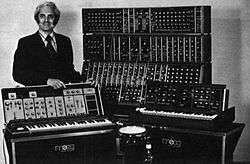
1960s – 1970s: Early years
The authors of Analog Days define "the early years of the synthesizer" as between 1964 and the mid-1970s, beginning with the debut of the Moog synthesizer.[4]:7 Designed by American engineer Robert Moog, the synthesizer was composed of separate modules which created and shaped sounds, connected by patch cords.[5] Moog developed a means of controlling pitch through voltage, the voltage-controlled oscillator.[6] This, along with Moog components such as envelopes, noise generators, filters, and sequencers, became standards in the synthesizer market.[7][4]
Around the same period, American engineer Don Buchla created the Buchla Modular Electronic Music System.[8] Instead of a conventional keyboard, Buchla's system used touchplates which transmitted control voltages depending on finger position and force.[4] However, the Moog's keyboard made it more accessible and marketable to musicians, and keyboards became the standard means of controlling synthesizers.[4] Moog and Buchla initially avoided the word synthesizer for their instruments, as it was associated with the RCA synthesizer; however, by the 1970s, "synthesizer" had become the standard term.[4] In 1970, Moog launched a cheaper, smaller synthesizer, the Minimoog.[9][10] The Minimoog was the first synthesizer sold in music stores,[4] and was more practical for live performance; it standardized the concept of synthesizers as self-contained instruments with built-in keyboards.[11][12]
After retail stores started selling synthesizers in 1971, other synthesizer companies were established, including ARP in the US and EMS in the UK.[4] ARP's products included the ARP 2600, which folded into a carrying case and had built-in speakers, and the Odyssey, a rival to the Minimoog.[4] The less expensive EMS synthesizers were used by European art rock and progressive rock acts including Brian Eno and Pink Floyd.[4] Designs for synthesizers appeared in the amateur electronics market, such as the "Practical Electronics Sound Synthesiser", published in Practical Electronics in 1973.[1] By the mid-1970s, ARP was the world's largest synthesizer manufacturer,[4] though it closed in 1981.[13]
Early synthesizers were monophonic, meaning they could only play one note at a time. Some of the earliest commercial polyphonic synthesizers were created by American engineer Tom Oberheim,[8] such as the OB-X (1979).[4] In 1978, the American company Sequential Circuits released the Prophet-5, first fully programmable polyphonic synthesizer.[7]:93 The Prophet-5 used microprocessors for patch memory, allowing users to store sounds.[14] This overcame a major difficulty in previous synthesizers, which required users to adjust cables and knobs to change sounds, with no guarantee of exactly recreating a sound.[4] This facilitated a move from synthesizers creating unpredictable sounds to producing "a standard package of familiar sounds".[4]:385
1980s: Market growth and digital technology
The synthesizer market grew dramatically in the 1980s.[7]:57 1982 saw the introduction of MIDI, a standardized means of synchronizing electronic instruments; it remains an industry standard.[15] An influential sampling synthesizer, the Fairlight CMI, was released in 1979,[14] with the ability to record and play back samples at different pitches.[16] Though its high price made it inaccessible to amateurs, it was adopted by high-profile pop musicians including Kate Bush and Peter Gabriel. The success of the Fairlight drove competition, improving sampling technology and lowering prices;[16] early competing samplers included the E-mu Emulator in 1981[16] and the Akai S-series in 1985.[17]
In 1983, Yamaha released the first commercially successful digital synthesizer, the Yamaha DX7.[18] Based on frequency modulation synthesis developed by Stanford University engineer John Chowning,[19] the DX7 remains one of the bestselling synthesizers in history[18][20] and was the first synthesizer to sell over 100,000 units.[7]:57 It was widely used in 1980s pop music.[21] Compared to the "warm" and "fuzzy" sounds of analog synthesis, the DX7 was characterized by its "harsh", "glassy" and "chilly" sounds.[2] Digital synthesizers typically contained preset sounds emulating acoustic instruments, with algorithms controlled with menus and buttons.[4]
The success of the DX7 led to competing digital synthesizers. The Roland D-50 (1987) blended Roland's linear arithmetic algorithm with samples, and was the first mass-produced synthesizer with built-in effects such as delay, reverb and chorus.[7]:63 In 1988, the Japanese manufacturer Korg released the M1, a digital synthesizer workstation featuring sampled transients and loops;[22] with over 250,000 units sold, it remains the bestselling synthesizer in history.[22] The advent of digital synthesizers led to a downturn in interest in analog synthesizers.[7]:59
1990s – present: Software synthesizers and analog revival
1997 saw the release of ReBirth by Propellerhead Software and Reality by Seer Systems, the first software synthesizers that could be played in real time via MIDI.[7] In 1999, an update to the music software Cubase allowed users to run software instruments (including synthesizers) as plug-ins, triggering a "torrent" of new software instruments.[23] Propellerhead's Reason, released in 2000, offered users a virtual "rack" of recognisable studio equipment.[23] Whereas once they had filled rooms, synthesizers now can be embedded on single microchips in any electronic device[4] and accurately emulated by software.[24]
The market for patchable and modular synthesizers rebounded in the late 1990s.[7]:32 In the 2000s, older analog synthesizers regained popularity, sometimes selling for much more than their original prices.[24] In the 2010s, new, affordable analog synthesizers were introduced by companies including Moog, Korg, Arturia, and Dave Smith Instruments. The renewed interest is credited to the appeal of imperfect "organic" sounds and simpler interfaces, and to modern surface-mount technology making analog synthesizers cheaper and faster to manufacture.[24]
Impact
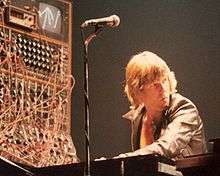
Early synthesizers were viewed as avant-garde, valued by the 1960s psychedelic and counter-cultural scenes for their ability to make new sounds, but with little perceived commercial potential. Switched-On Bach (1968), a bestselling album of Bach compositions arranged for Moog synthesizer by Wendy Carlos, demonstrated that synthesizers could be more than "random noise machines",[5] taking them to the mainstream.[4] However, debates were held about the appropriateness of synthesizers in baroque music, and according to the Guardian they were quickly abandoned in "serious classical circles".[25]
The Moog was adopted by acts including the Doors, the Grateful Dead, the Rolling Stones, the Beatles, and Keith Emerson.[26] Emerson was the first major rock musician to perform with the Moog and it became a trademark of his performances, helping take his band Emerson, Lake & Palmer to global stardom; according to Analog Days, the likes of Emerson, with his Moog performances, "did for the keyboard what Jimi Hendrix did for the guitar".[4]:200
The portable Minimoog (1970), much smaller than the modular synthesizers before it, made synthesizers more common in live performance.[12] The Minimoog took a place in mainstream black music, most notably in the work of Stevie Wonder,[4] and in jazz, such as the work of Sun Ra.[27] It was also used by electronic artists such as Kraftwerk, who used it on their albums Autobahn (1974) and The Man-Machine (1978), and later by Tangerine Dream, Klaus Schulze, and Gary Numan.[27] In the late 1970s and the early 1980s, the Micromoog was widely used in the emerging disco genre by artists including Abba and Giorgio Moroder.[27] Some acts felt that using synthesizers to create sounds was "cheating"; Queen wrote in their album liner notes that they did not use them.[28]
Early synthesizers could only play one note at a time, making them suitable for basslines, leads and solos.[27] With the rise of polyphonic synthesizers in the 70s and 80s, "the keyboard in rock once more started to revert to the background, to be used for fills and atmosphere rather than for soloing".[4]:207 Sampling, introduced with the Fairlight synthesizer in 1979, has influenced all genres of music[6] and had a major influence on the development of electronic and hip hop music.[29][30]
In the 1970s, electronic music composers such as Jean Michel Jarre[31] and Isao Tomita[32][33][34] released successful synthesizer-led instrumental albums. This influenced the emergence of synthpop, a subgenre of new wave, from the late 1970s to the early 1980s. The work of German krautrock bands such as Kraftwerk[35] and Tangerine Dream, British acts such as John Foxx, Gary Numan and David Bowie, African-American acts such as George Clinton and Zapp, and Japanese electronic acts such as Yellow Magic Orchestra and Kitaro were influential in the development of the genre.[36] Gary Numan's 1979 hits "Are 'Friends' Electric?" and "Cars" made heavy use of synthesizers.[37][38] OMD's "Enola Gay" (1980) used distinctive electronic percussion and a synthesized melody. Soft Cell used a synthesized melody on their 1981 hit "Tainted Love".[36] Nick Rhodes, keyboardist of Duran Duran, used various synthesizers including the Roland Jupiter-4 and Jupiter-8.[39] Chart hits include Depeche Mode's "Just Can't Get Enough" (1981),[36] the Human League's "Don't You Want Me"[40] and works by Ultravox.[36]
In the 1980s, digital synthesizers were widely used in pop music.[21] The Yamaha DX7, released in 1983, became a pop staple, used on songs by A-ha, Kenny Loggins, Kool & the Gang.[2] Its "E PIANO 1" preset became particularly famous,[2] especially for power ballads,[41] and was used by artists including Whitney Houston, Chicago,[41] Prince,[21] Phil Collins, Luther Vandross, Billy Ocean,[2] and Celine Dion.[42] The Roland TB-303 (1981), in conjunction with the Roland TR-808 and TR-909 drum machines, became a foundation of electronic dance music genres such as house and techno when producers acquired cheap second-hand units later in the decade.[43] Korg M1 presets were widely used in 1990s house music, beginning with Madonna's 1990 single "Vogue".[44]
Today, the synthesizer is used in nearly every genre of music.[4]:7 It is considered by the authors of Analog Days "the only innovation that can stand alongside the electric guitar as a great new instrument of the age of electricity ... Both led to new forms of music, and both had massive popular appeal."[4]:7 The authors draw a connection to the synthesizer's origins in 1960s psychedelia to the raves and British "second summer of love" of the 1980s and the club scenes of the 1990s and 2000s.[4]:321 According to Fact in 2016, "The synthesizer is as important, and as ubiquitous, in modern music today as the human voice."[2] It is one of the most important instruments in the music industry.[36]
Film and television
Synthesizers are common in film and television soundtracks.[4]:273 ARP synthesizers, for example, were used to create sound effects for the 1977 science fiction films Close Encounters of the Third Kind[4]:9 and Star Wars, including the "voice" of the robot R2-D2.[4]:273 In the 70s and 80s, synthesizers were used in the scores for thrillers and horror films including A Clockwork Orange (1971), Apocalypse Now (1979), The Fog (1980) and Manhunter (1986). They were also used to create themes for television shows including Knight Rider (1982), Twin Peaks (1990) and Stranger Things (2016).[45]
Jobs
The rise of the synthesizer led to major changes in music industry jobs, comparable to the earlier arrival of sound in film, which put live musicians accompanying silent films out of work.[46] With its ability to imitate instruments such as strings and horns, the synthesizer threatened the jobs of session musicians. For a period, the Moog was banned from use in commercial work, a restriction negotiated by the American Federation of Musicians (AFM).[4] Robert Moog felt that the AFM had not realized that his instrument had to be studied like any other, and instead imagined that "all the sounds that musicians could make somehow existed in the Moog — all you had to do was push a button that said 'Jascha Heifetz' and out would come the most fantastic violin player".[47]
Musician Walter Sear persuaded the AFM that the synthesizer demanded skill, and the category of "synthesizer player" was accepted into the union; however, players were still subject to "suspicion and hostility" for several years.[4]:149 In 1982, following a tour by Barry Manilow using synthesizers instead of an orchestra, the British Musicians' Union attempted to ban synthesizers, attracting controversy.[48] That decade, a few musicians skilled at programming the popular Yamaha DX7 found employment creating sounds for other acts.[49]
Sound synthesis
Additive synthesis builds sounds by combining several waveforms, usually sine waves, into a composite sound.[7]
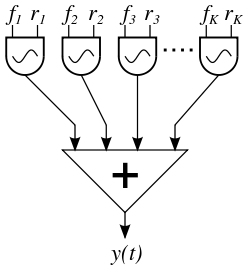

Subtractive synthesis uses oscillators to generate waveforms, then shapes them with filters to remove or boost specific frequencies.[7]

Frequency modulation (FM) synthesis creates sounds by modulating one waveform with the frequency of another; the resulting complex waveform can, in turn, be used to modulate another, and this another, and so on. FM synthesis can imitate acoustic sounds such as piano, strings and organs.[50]
Phase distortion synthesis is a method implemented on Casio CZ synthesizers. It replaces the traditional analog waveform with a choice of several digital waveforms which are more complex than the standard square, sine, and sawtooth waves. This waveform is routed to a digital filter and digital amplifier, each modulated by an eight-stage envelope. The sound can then be further modified with ring modulation or noise modulation.[51]

Physical modelling synthesis is the synthesis of sound by using a set of equations and algorithms to simulate each sonic characteristic of an instrument, starting with the harmonics that make up the tone itself, then adding the sound of the resonator, the instrument body, etc., until the sound realistically approximates the desired instrument. When an initial set of parameters is run through the physical simulation, the simulated sound is generated. Although physical modeling was not a new concept in acoustics and synthesis, it was not until the development of the Karplus-Strong algorithm and the increase in DSP power in the late 1980s that commercial implementations became feasible. The quality and speed of physical modeling on computers improves with higher processing power.
Linear arithmetic synthesis is a form of synthesis developed by Roland[52] that utilizes PCM samples for the attack of a waveform, and subtractive synthesis for the rest of the envelope. This type of synthesis bridges the gap between the older subtractive synthesis and the newer sample-based synthesis at a time where PCM samples would take up a substantial amount of the memory allotted. The first synthesizer to debut with this form of synthesis was the Roland D-50 in 1987.[53]
Sample-based synthesis involves digitally recording a short snippet of sound from a real instrument or other source and then playing it back at different speeds to produce different pitches. A sample can be played as a one shot, used often for percussion or short duration sounds, or it can be looped, which allows the tone to sustain or repeat as long as the note is held. Samplers usually include a filter, envelope generators, and other controls for further manipulation of the sound. Virtual samplers that store the samples on a hard drive make it possible for the sounds of an entire orchestra, including multiple articulations of each instrument, to be accessed from a sample library. See also Wavetable synthesis, Vector synthesis.
Analysis/resynthesis is a form of synthesis that uses a series of bandpass filters or Fourier transforms to analyze the harmonic content of a sound. The results are then used to resynthesize the sound using a band of oscillators. The vocoder, linear predictive coding, and some forms of speech synthesis are based on analysis/resynthesis.
Components
Synthesizers generate sound through various analogue and digital techniques. Early synthesizers were analog hardware based but many modern synthesizers use a combination of DSP software and hardware or else are purely software-based (see softsynth). Digital synthesizers often emulate classic analog designs. Sound is controllable by the operator by means of circuits or virtual stages that may include:
- Oscillators typically produce waveforms (such as sawtooth, sine, or pulse waves) with different timbres.[7]
- Low-frequency oscillators (LFOs) produce waveforms used to modulate parameters, such as the pitch of oscillators (producing vibrato).[7]
- Voltage-controlled filter (VCFs) – "shape" the sound generated by the oscillators in the frequency domain, often under the control of an envelope or LFO. These are essential to subtractive synthesis.
- Envelope generators – provide envelope modulation to "shape" the volume or harmonic content of the produced note in the time domain with the principal parameters being attack, decay, sustain and release. These are used in most forms of synthesis. ADSR control is provided by envelope generators.
- Voltage-controlled amplifiers (VCAs) control the volume or gain of the audio signal. VCAs can be modulated by other components, such as LFOs and envelopes.[7]
- After the signal generated by one (or a mix of more) VCOs has been modified by filters and LFOs, and its waveform has been shaped (contoured) by an ADSR envelope generator, it then passes on to one or more voltage-controlled amplifiers (VCAs). A VCA is a preamp that boosts (amplifies) the electronic signal before passing it on to an external or built-in power amplifier, as well as a means to control its amplitude (volume) using an attenuator. The gain of the VCA is affected by a control voltage (CV), coming from an envelope generator, an LFO, the keyboard or some other source.[54]
Filter

Filters are particularly important in subtractive synthesis, being designed to pass some frequency regions (or "bands") through unattenuated while significantly attenuating ("subtracting") others. The low-pass filter is most frequently used, but band-pass filters, band-reject filters and high-pass filters are also sometimes available.
The filter may be controlled with a second ADSR envelope. An "envelope modulation" ("env mod") parameter on many synthesizers with filter envelopes determines how much the envelope affects the filter. If turned all the way down, the filter produces a flat sound with no envelope. When turned up the envelope becomes more noticeable, expanding the minimum and maximum range of the filter. The envelope applied on the filter helps the sound designer generating long notes or short notes by moving the parameters up and down such as decay, sustain and finally release. For instance by using a short decay with no sustain, the sound generated is commonly known as a stab. Sound designers may prefer shaping the sound with filter instead of volume.
Envelope
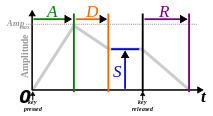
Envelopes control how sounds change over time. They may control parameters such as amplitude (volume), filters (frequencies), or pitch. The most common envelope is the ADSR (attack, decay, sustain, release) envelope:[7]
- Attack time is the time taken for initial run-up of level from nil to peak, beginning when the note is triggered.
- Decay time is the time taken for the subsequent run down from the attack level to the designated sustain level.
- Sustain level is the level during the main sequence of the sound's duration, until the key is released.
- Release time is the time taken for the level to decay from the sustain level to zero after the key is released.
LFO
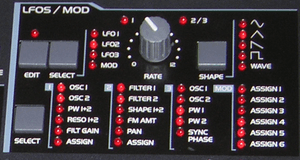
A low-frequency oscillator (LFO) generates an electronic signal, usually below 20 Hz. LFO signals create a periodic control signal or sweep, often used in vibrato, tremolo and other effects. In certain genres of electronic music, the LFO signal can control the cutoff frequency of a VCF to make a rhythmic wah-wah sound, or the signature dubstep wobble bass.
Arpeggiator
An arpeggiator (arp) is a feature available on several synthesizers that automatically steps through a sequence of notes based on an input chord, thus creating an arpeggio. The notes can often be transmitted to a MIDI sequencer for recording and further editing. An arpeggiator may have controls for speed, range, and order in which the notes play; upwards, downwards, or in a random order. More advanced arpeggiators allow the user to step through a pre-programmed complex sequence of notes, or play several arpeggios at once. Some allow a pattern sustained after releasing keys: in this way, a sequence of arpeggio patterns may be built up over time by pressing several keys one after the other. Arpeggiators are also commonly found in software sequencers. Some arpeggiators/sequencers expand features into a full phrase sequencer, which allows the user to trigger complex, multi-track blocks of sequenced data from a keyboard or input device, typically synchronized with the tempo of the master clock.
Arpeggiators seem to have grown from the accompaniment system used in electronic organs in the mid-1960s to the mid-1970s.[55] They were also commonly fitted to keyboard instruments through the late 1970s and early 1980s. Notable examples are the RMI Harmonic Synthesizer (1974),[56] Roland Jupiter-8, Oberheim OB-8, Roland SH-101, Sequential Circuits Six-Trak and Korg Polysix. A famous example can be heard on Duran Duran's song "Rio", in which the arpeggiator on a Roland Jupiter-4 plays a C minor chord in random mode. They fell out of favor by the latter part of the 1980s and early 1990s and were absent from the most popular synthesizers of the period but a resurgence of interest in analog synthesizers during the 1990s, and the use of rapid-fire arpeggios in several popular dance hits, brought with it a resurgence.
Controllers
Synthesizers are often controlled with electronic or digital keyboards or MIDI controller keyboards, which may be built into the synthesizer unit or attached via connections such as CV/gate, USB, or MIDI.[7] Keyboards may offer expression such as velocity sensitivity and aftertouch, allowing for more control over the sound.[7] Other controllers include ribbon controllers, which track the movement of the finger across a touch-sensitive surface; wind controllers, played similarly to woodwind instruments;[7] motion-sensitive controllers similar to video game motion controllers;[7] electronic drum pads, played similarly to the heads of a drum kit;[7] touchplates, which send signals depending on finger position and force;[7] controllers designed for microtonal tunings;[7] touchscreen devices such as tablets and smartphones;[7] and fingerpads.[7]
Clones
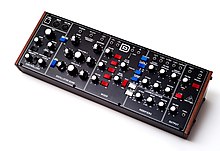
Synthesizer clones are unlicensed recreations of previous synthesizers, often marketed as affordable versions of famous musical equipment. Clones are available as physical instruments and software. Companies that have sold software clones include Arturia and Native Instruments. Behringer manufactures equipment modelled on instruments including the Minimoog, Pro-One, TB-303, and drum machines such as the TR-808. Other synthesizer clones include the MiniMOD (a series of Eurorack modules based on the Minimoog), the Intellijel Atlantis (based on the SH-101), and the x0x Heart (based on the TB-303).[57]
Creating clones of older hardware is legal where the patents have expired.[57] In 1997, Mackie lost their lawsuit against Behringer[58] as copyright law in the United States did not cover their circuit board designs.[57] In 2006, Roland and Behringer reached a settlement after Roland claimed Behringer's effects units were too similar to its Boss pedals.[59]
See also
- Lists
- Various synthesizers
- Guitar synthesizer
- Keytar
- Modular synthesizer
- Semi-modular synthesizer
- String synthesizer
- Wind controller
- Related instruments & technologies
- Clavioline (Musitron)
- Electronic keyboard
- Musical instrument
- Music workstation
- Sampler
- Speech synthesis
- Components & technologies
- Music genres
- Notable works
References
- Shaw, G D (February 1973). "Sound Synthesiser". Practical Electronics. Vol. 9 no. 2. p. 140. Retrieved 10 January 2020.
- "The 14 most important synths in electronic music history – and the musicians who use them". FACT Magazine: Music News, New Music. 15 September 2016. Retrieved 19 October 2018.
- Chadabe, Joel (14 September 2011). "The Electronic Century Part I: Beginnings". Electronic Musician. Archived from the original on 14 September 2011. Retrieved 12 November 2019.
- Pinch, Trevor; Trocco, Frank (2004). Analog Days: The Invention and Impact of the Moog Synthesizer. Harvard University Press. ISBN 978-0-674-01617-0.
- Kozinn, Allan. "Robert Moog, Creator of Music Synthesizer, Dies at 71". New York Times. Retrieved 3 December 2018.
- McNamee, David (2 August 2010). "Hey, what's that sound: Moog synthesisers". The Guardian. Retrieved 8 January 2020.
- Vail, Mark (2014). The Synthesizer. Oxford University Press. ISBN 978-0195394894.
- Lee, Sammy (3 July 2018). "This is the early history of the synthesizer". Red Bull Music. Retrieved 2 November 2019.
- Bernstein, Adam (23 August 2005). "Robert Moog Dies; Created Electronic Synthesizer". ISSN 0190-8286. Retrieved 3 December 2018.
- "Red Bull Music Academy Daily". daily.redbullmusicacademy.com. Retrieved 28 November 2018.
- "Clear Some Space on Your Synth Rack: The Minimoog Returns". WIRED. Retrieved 28 November 2018.
- Franklin Crawford (August 23, 2005). "Robert Moog, Ph.D. '64, inventor of the music synthesizer, dies of brain cancer". Cornell University News Service. Retrieved 4 May 2007.
- "ARP Instruments founder Alan R. Pearlman dies aged 93". FACT Magazine. 7 January 2019. Retrieved 12 April 2020.
- "The 14 most important synths in electronic music history – and the musicians who use them". Fact. 15 September 2016. Retrieved 17 October 2018.
- "The life and times of Ikutaro Kakehashi, the Roland pioneer modern music owes everything to". FACT Magazine: Music News, New Music. 2 April 2017. Retrieved 6 September 2018.
- Howell, Steve (August 2015). "The Lost Art Of Sampling: Part 1". Sound on Sound. Retrieved 12 October 2018.
- "A brief history of sampling". MusicRadar. Retrieved 12 October 2018.
- Shepard, Brian K. (2013). Refining Sound: A Practical Guide to Synthesis and Synthesizers. Oxford University Press. ISBN 9780199376681.
The first digital synthesizer to make it into the studios of everyone else, the Yamaha DX7, became one of the most commercially successful synthesizers of all time.
- Holmes, Thom (2008). "Early Computer Music". Electronic and experimental music: technology, music, and culture (3rd ed.). Taylor & Francis. p. 257. ISBN 978-0-415-95781-6. Retrieved 4 June 2011.
- Holmes, Thom (2008). "Early Computer Music". Electronic and experimental music: technology, music, and culture (3rd ed.). Taylor & Francis. p. 257. ISBN 978-0415957816. Retrieved 4 June 2011.
- Brøvig-Hanssen, Ragnhild; Danielsen, Anne (19 February 2016). Digital Signatures: The Impact of Digitization on Popular Music Sound. MIT Press. ISBN 9780262034142.
- Vail, Mark (February 2002). "Korg M1 (Retrozone)". Sound on Sound. Retrieved 6 November 2019.
- Tech, Computer Music Specials 2008-10-13T15:29:00 286Z. "A brief history of computer music". MusicRadar. Retrieved 1 November 2019.
- "The Analogue Revival". Sound on Sound. March 2014. Retrieved 6 November 2019.
- Stearns, David Patrick (25 August 2005). "Obituary: Robert Moog". The Guardian. ISSN 0261-3077. Retrieved 13 January 2020.
- "Obituary: Dr Robert Moog". BBC News. 22 August 2005. Retrieved 3 December 2018.
- Weiner, Sophie (20 October 2017). "Minimoog: The First Truly Portable Synthesizer". Red Bull Music Academy. Retrieved 28 November 2018.
- Snowden, Don (23 May 2012). "Robert Moog: 'I wouldn't call this music' – a classic interview to mark a Google doodle". The Guardian. ISSN 0261-3077. Retrieved 13 January 2020.
- "Hip-hop's most influential sampler gets a 2017 reboot". Engadget. Retrieved 3 April 2018.
- "Meet the unassuming drum machine that changed music forever". Vox. Retrieved 11 May 2018.
- "Jean Michel Jarre | Biography, Albums, Streaming Links | AllMusic". AllMusic. Retrieved 12 December 2017.
- Mark Jenkins (2007), Analog synthesizers: from the legacy of Moog to software synthesis, Elsevier, pp. 133–4, ISBN 978-0-240-52072-8, retrieved 27 May 2011
- Tomita at AllMusic. Retrieved 2011-06-04.
- "Snowflakes Are Dancing". Billboard. Retrieved 28 May 2011.
- "Kraftwerk". Discogs. Retrieved 12 December 2017.
- Borthwick 2004, p. 120
- George-Warren, Holly (2001), The Rolling Stone Encyclopedia of Rock & Roll, Fireside, pp. 707–734, ISBN 0-7432-0120-5
- Robbins, Ira A (1991), The Trouser Press Record Guide, Maxwell Macmillan International, p. 473, ISBN 0-02-036361-3
- Black, Johnny (2003), "The Greatest Songs Ever! Hungry Like the Wolf", Blender (January/February 2003), archived from the original on 13 October 2007, retrieved 16 April 2008
- Borthwick 2004, p. 130
- Simpson, Dave (14 August 2018). "More synthetic bamboo! The greatest preset sounds in pop music". the Guardian. Retrieved 19 October 2018.
- Saxelby, Ruth. "Borne into the 90s [pt.1]". Dummy Mag. Retrieved 15 September 2011.
- Beaumont-Thomas, Ben (14 February 2014). "Roland launch new versions of the iconic 808, 909 and 303 instruments". The Guardian. ISSN 0261-3077. Retrieved 2 November 2019.
- "A Beginner's Guide To The Synth". Gizmodo Australia. 29 December 2015. Retrieved 28 April 2019.
- "A tribute to the synth: how synthesisers revolutionised modern music". BBC. Retrieved 6 November 2019.
- From Stage to Studio: Musicians and the Sound Revolution, 1890–1950 (Baltimore: Johns Hopkins University Press, 1996).
- Interview with Bob Moog, Plug, Fall 1974,p.2.
- "1981–1990 – The Musicians' Union: A History (1893–2013)". www.muhistory.com.
- Roger T. Dean, ed. (16 September 2009). The Oxford Handbook of Computer Music. Oxford University Press. p. 81. ISBN 9780199887132.
- Crute, Adam (1 July 2019). "Learning the basics of FM synthesis and how it works". MusicTech. Retrieved 6 November 2019.
- "CZ-101 Manual" (PDF). Retrieved 2 January 2019.
- "Linear Arithmetic Synthesis | Sweetwater". inSync. 11 April 2005. Retrieved 28 April 2020.
- "Linear Arithmetic (LA) Synthesis". SoundBridge. 17 March 2017. Retrieved 28 April 2020.
- Reid, Gordon (2000). "Synth Secrets, Part 9: An Introduction to VCAs". Sound on Sound (January 2000). Archived from the original on 4 April 2016. Retrieved 25 May 2010.CS1 maint: BOT: original-url status unknown (link)
- US patent 3,358,070, Alan C. Young (Hammond Co.), "Electronic Organ Arpeggio Effect Device", issued 1967-12-12
- "RMI Harmonic Synthesizer". Jarrography – The ultimate Jean Michel Jarre discography.
- Warwick, Oli (8 April 2017). "Attack of the clones: Is Behringer's Minimoog a synth replica too far?". Fact. Retrieved 30 November 2018.
- Inc, Nielsen Business Media (5 July 1997). Billboard. Nielsen Business Media, Inc.
- "Behringer and Roland Settle Lawsuit". Mixonline. Retrieved 30 November 2018.
Bibliography
- Borthwick, Stuart (2004), Popular Music Genres: An Introduction, Edinburgh University Press, p. 120, ISBN 0-7486-1745-0CS1 maint: ref=harv (link)
- Holmes, Thom (2008), Electronic and experimental music: technology, music, and culture (3rd ed.), Taylor & Francis, ISBN 978-0-415-95781-6, retrieved 4 June 2011
- Vail, Mark (2000), Vintage Synthesizers: Groundbreaking Instruments and Pioneering Designers of Electronic Music Synthesizers, Backbeat Books, pp. 68–342, ISBN 0-87930-603-3
Further reading
- Crombie, David (1986). New Complete Synthesizer. Omnibus Press. ISBN 0711907013.CS1 maint: ref=harv (link)
- Gorges, Peter (2005). Programming Synthesizers. Germany, Bremen: Wizoobooks. ISBN 978-3-934903-48-7.CS1 maint: ref=harv (link)
- Schmitz, Reinhard (2005). Analog Synthesis. Germany, Bremen: Wizoobooks. ISBN 978-3-934903-01-2.CS1 maint: ref=harv (link)
- Shapiro, Peter (2000). Modulations: A History of Electronic Music: Throbbing Words on Sound. Caipirinha Productions, USA. ISBN 1-891024-06-X.CS1 maint: ref=harv (link)
- Kuit, Roland (2014). SoundLab I: The Electronic Studio. Publisher's number: 13664. The Netherlands, The Hague: Donemus.CS1 maint: ref=harv (link)
- Kuit, Roland (2014). SoundLab II: Architectures for Philosophers. Publisher's number: 13665. The Netherlands, The Hague: Donemus.CS1 maint: ref=harv (link)
- Kuit, Roland (2014). Laboratory of Patching: Illustrated Compendium of Modular Synthesis. Publisher's number: 13662. The Netherlands, The Hague: Donemus.CS1 maint: ref=harv (link)
- Kuit, Roland (2014). To be On, to be OFF, that's the SWITCH. Publisher's number: 13666. The Netherlands, The Hague: Donemus.CS1 maint: ref=harv (link)
External links
| Look up synthesizer in Wiktionary, the free dictionary. |
| Wikimedia Commons has media related to Synthesizers. |
- Sound Synthesis Theory wikibook
- Principles of Sound Synthesis at Salford University
- Synthesizer Tutorial

%2C_June_13%2C_2011.jpg)